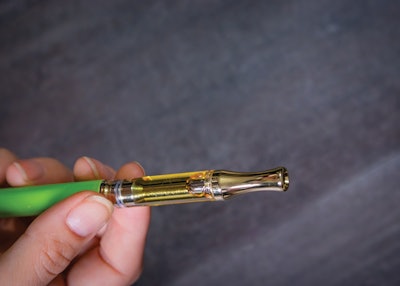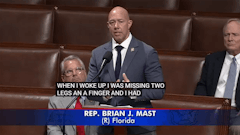
Federal health officials announced Nov. 8 that vitamin E acetate has been found in the lung fluids of 29 patients affected by the outbreak of vaping-related lung injuries—a breakthrough that identifies the vape cartridge additive as the likely culprit in the epidemic.
The Centers for Disease Control and Prevention (CDC), the Food and Drug Administration (FDA), state and local health departments, and multiple public health and clinical partners have been investigating the nationwide outbreak of vape-related illnesses—referred to as “e-cigarette, or vaping, product use-associated lung injury (EVALI)—which first grabbed national headlines in early September.
Based on data collected as of Oct. 15, 86% of 867 affected patients reported using THC products in the three months before the onset of symptoms, according to the CDC’s announcement, and subsequent analyses of THC-containing product samples revealed potentially harmful additives, including vitamin E acetate and medium chain triglyceride oil (MCT oil). These additives, particularly vitamin E acetate, are primarily used as a thickening agent in THC products.
Bronchoscopy and bronchoalveolar lavage (BAL) fluid samples were collected by the clinical teams caring for patients afflicted with vape-related lung injuries, according to the announcement. Public health laboratories from California, Connecticut, Hawaii, Illinois, Maryland, Michigan, Minnesota, Texas, Utah and Wisconsin then submitted samples from 29 patients to the CDC, which developed and validated testing methods to analyze the specific substances of concern and active compounds found in the BAL fluid.
Vitamin E acetate was detected in all 29 BAL fluid samples.
THC or its metabolites were detected in 23 of the samples, according to the CDC, and nicotine metabolites were detected in 16.
“These findings provide direct evidence of vitamin E acetate at the primary site of injury among EVALI patients and are consistent with FDA product testing and media reports of state public health laboratory testing documenting vitamin E acetate in product samples used by EVALI patients,” the CDC said. “Other diluents and additives of concern (e.g., plant oils, MCT oil, petroleum distillates, and diluent terpenes) were notably not detected in BAL fluid specimens from EVALI patients.”
Even so, the CDC added that additional studies are needed, including a comparison of BAL fluid samples from healthy volunteers and animal studies, to determine whether there is a causal link between vitamin E acetate exposure and the lung injuries.
“Based on these data from 29 patients, it appears that vitamin E acetate is associated with EVALI; however, it is possible that more than one compound or ingredient could be a cause of lung injury, and evidence is not yet sufficient to rule out contribution of other toxicants to EVALI,” the CDC said.
Industry stakeholders, such as the Cannabis Trade Federation (CTF), view the CDC’s discovery as a major step forward in solving the vape epidemic.
“We applaud the CDC and other federal and state health officials for their efforts thus far to identify the cause or causes of the reported outbreak of pulmonary-related illnesses associated with the use of vaporization products,” the organization said in a public statement. “While it still appears these health incidents are primarily associated with the use of illicit THC vape products, we urge members of the regulated cannabis industry to be vigilant and review all of their vaping products to ensure they are free of vitamin E acetate. CTF also urges officials in states that have regulated cannabis for medical or adult use to review their states’ regulations to ensure vitamin E acetate is clearly prohibited from being used in any inhalable cannabis products.
“This health crisis and the recent breakthrough in the investigation underscore the importance of existing state cannabis regulations, as well as the need for strict cannabis regulation at both the state and federal levels.”
Some states have indeed started more tightly regulating vapes and their additives, while others have banned vape products altogether. Colorado regulators, for example, have taken steps to ban polyethylene glycol (PEG), vitamin E acetate and MCT oil, while Washington and Oregon adopted emergency rules that ban the sale of flavored vape products. Massachusetts is working through the legal technicalities of banning all vape products in the state, although a judge ruled earlier this week that the ban must be lifted on medical cannabis vapes.
Other states have not yet responded to the vape crisis.
“The CDC’s announcement highlights the urgent need for Michigan to crack down on bad actors and black-market operators who are selling untested, dangerous products and passing it off as medicine,” said Michael Elias, CEO of Michigan Pure Med and Common Citizen, in a public statement. “There have been more than 2,000 vaping-related lung injuries and more than three dozen deaths because of harmful cutting-agents found in illicit vape products, and this is unacceptable, which is why we need stronger enforcement of the illicit cannabis market.”
Vitamin E acetate has long been the suspected culprit in the outbreak of vape-related lung injuries, although, as the CDC pointed out in its announcement, many unanswered questions still remain.
The CDC concluded that until the relationship of vitamin E acetate and lung health is better understood, vitamin E acetate should not be added to vaping products.


























